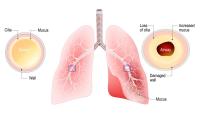Bronchiectasis Diagnosis and Treatment
Make an Appointment
Our experienced team is here to help you learn more about our program, to schedule an appointment, or to help with a referral.
Nationally Recognized Care for Bronchiectasis
As part of the Bronchiectasis and NTM Care Center Network, Columbia University connects patients to nationally recognized expertise in managing bronchiectasis and related chronic lung diseases. This designation ensures patients receive:
- Accelerated diagnosis through specialized, comprehensive evaluations.
- Individualized treatment plans tailored to each patient's unique needs.
- Access to cutting-edge research and participation in clinical trials.
- Free educational materials developed with leading experts and advocacy groups.
- Patient-centered resources, including support groups and long-term disease management tools.
Columbia's participation in this network reflects its dedication to delivering exceptional care, improving patient outcomes, and advancing awareness and research for bronchiectasis and NTM.
Bronchiectasis Diagnosis at Columbia
At Columbia, our expert team uses a combination of advanced diagnostic tools and a personalized approach to ensure an accurate and comprehensive assessment of bronchiectasis. Our diagnostic process includes:
- Chest computerized tomography (CT) scans.
- Bronchoscopy.
- Pulmonary function tests.
- Blood and sputum tests.
Because bronchiectasis can have many underlying causes, our specialists also perform targeted tests to identify contributing factors, such as immune deficiencies, infections, or genetic conditions. This thorough approach allows us to craft individualized treatment plans designed to address both the symptoms and the root causes of the disease. At Columbia, you can trust that your respiratory health is in expert hands.
Bronchiectasis Treatment at Columbia
Bronchiectasis treatments focus on eliminating/controlling infections and clearing mucus to make it easier to breathe. Some treatments are used for daily maintenance, while others help during flare-ups. Treatment will vary based on the underlying cause. Options include:
- Antibiotics
- Medications to thin mucus
- Airway clearance devices
- Positive expiratory pressure (PEP) devices
- Percussive vests
- Physical therapy for clearing mucus from the lungs
Current Bronchiectasis clinical trials explore new treatment options, including new medical therapies to target NTM infections.
Managing Bronchiectasis
Patients can make lifestyle changes to help reduce the risk of a flare-up. These include:
- Not smoking/stopping smoking
- Taking maintenance medications
- Staying hydrated
- Exercising
- Getting regular flu and pneumonia vaccinations
The outlook for people with bronchiectasis has improved dramatically over the past few decades. Working with a specialist to develop an individualized treatment can help manage symptoms and dramatically improve quality of life.

